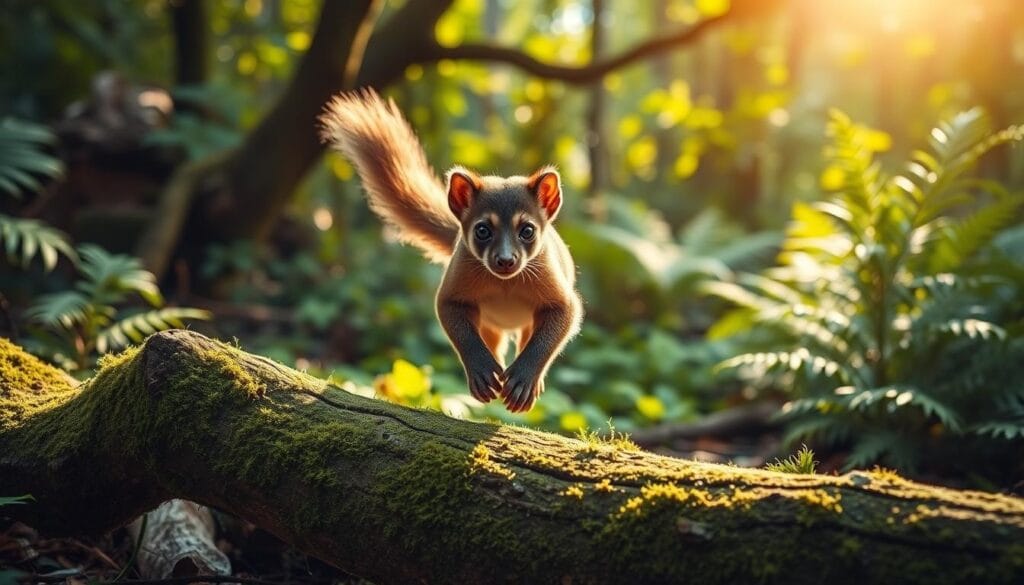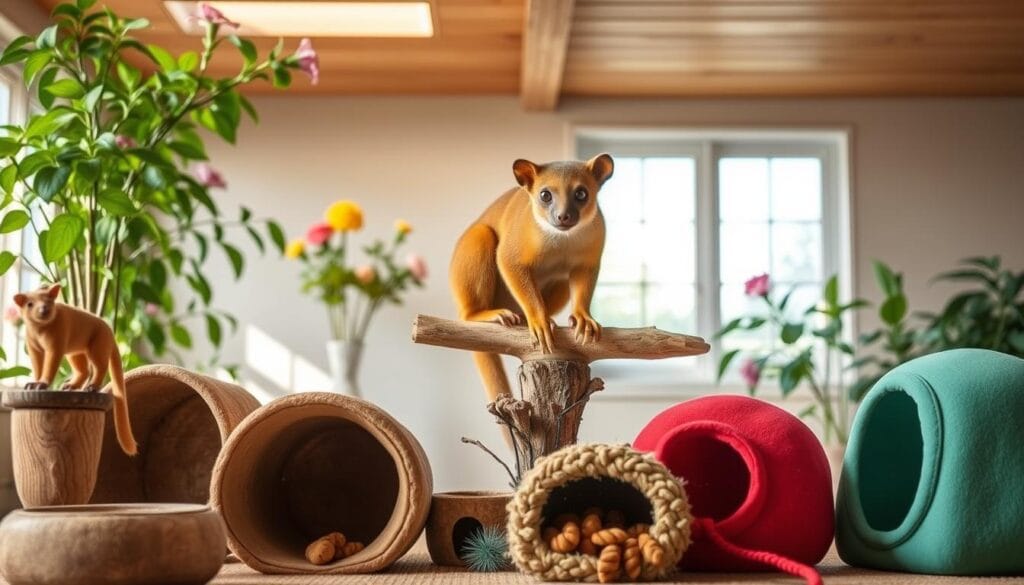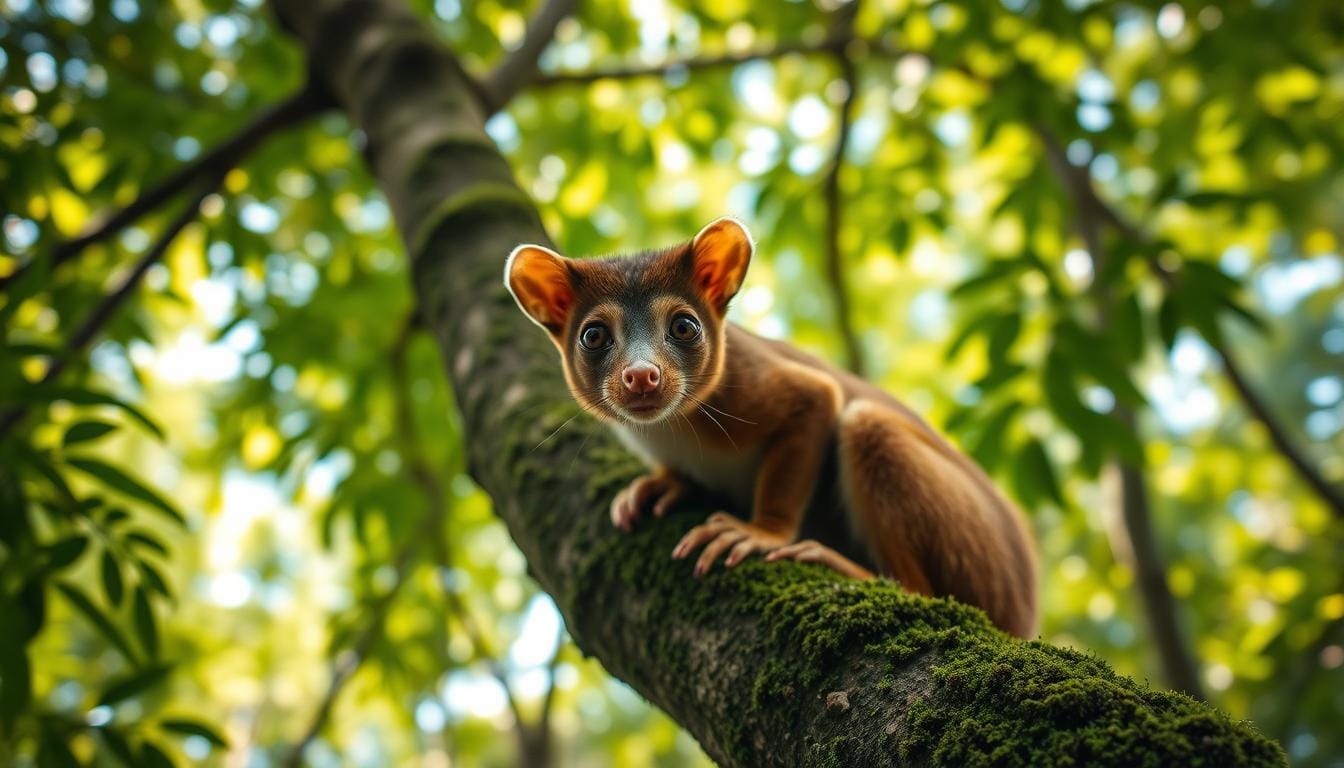In 2023, a kinkajou was found in Washington state, very thin. This shows the dangers of having exotic pets. The Port Defiance Zoo helped it, but it’s clear kinkajous belong in rainforests, not homes. Their yellow fur and big eyes are cute, but they have wild instincts.
Kinkajous have behaviors shaped by their wild life. They are not meant to be pets. Between 2011 and 2016, more Americans got exotic pets, but many don’t know the challenges. Laws on exotic pets vary a lot—20 states ban them, but 3 have no rules. Ignoring their wild nature can be dangerous, as seen in the 65+ deaths from exotic pets since 1990.
Table of Contents
Understanding Kinkajous: An Overview
Kinkajous are fascinating mammals that look like monkeys. They belong to the Procyonidae family, which includes raccoons. These animals live in tropical rainforests from Mexico to Brazil.
Their bushy tails and sharp claws help them move through trees easily.
What is a Kinkajou?
- Size: Adults weigh 3–10 pounds, with bodies 16–24 inches long.
- Diet: 90% fruit-based, supplemented with nectar, insects, and occasional small vertebrates.
- Key trait: Nocturnal, active between 7 p.m. and midnight.
Natural Habitat and Behavior
Wild kinkajous live in dense rainforests where they forage at night. Their behavior revolves around:
- Climbing: Using tails as “fifth limbs” to grip branches.
- Feeding: Prioritizing ripe figs and mangoes.
- Resting: Sleeping in tree hollows during daylight.
Social Structure in the Wild
In nature, they live in small groups of 4–6 individuals. Social bonds form around shared feeding grounds. While they mostly forage alone, they communicate through chirps and scent markings.
These patterns shape their needs as pets—requiring both space to explore and opportunities for interaction.
Kinkajou Personality Traits
Getting to know your kinkajou starts with understanding their natural ways. They often surprise new owners with their mix of curiosity and need for company. These traits make them fun but also bring some challenges to your home.
Playfulness and Curiosity
Kinkajous are full of play and curiosity. They love to check out everything, from bags to countertops. Their curiosity leads to fun explorations, like taking apart cabinets or making sounds.
Keeping them busy with puzzle toys or hanging branches is a great idea. It keeps their minds sharp and active.
Affectionate Nature
Kinkajous are known for their loving nature. They might snuggle up close or even groom your hair. But, each kinkajou is different, with some wanting lots of attention and others preferring less.
Being patient and consistent helps build a strong bond. Rewarding them with treats during calm moments can be very rewarding.
Intelligence and Problem Solving
In the wild, kinkajous use their smarts to find food and avoid dangers. At home, they show off their cleverness by figuring out locks or finding hidden snacks. Studies show they even use tools to get to nectar, showing off their advanced thinking.
Make sure to provide them with puzzles to keep their minds engaged. This helps prevent boredom and mischief.
Communication: How Kinkajous Express Themselves
Understanding your kinkajou’s communication is key to meeting their needs. By observing kinkajou behavior patterns, you can see their mood. Their sounds and body language are a language you can learn.
Vocalizations: Sounds and Meaning
Pay attention to these important sounds:
- Barks: Short, sharp barks mean alarm or defending their territory.
- Chirps: High-pitched chirps show excitement during play or when they’re fed.
- Screams: Long, high-pitched cries might mean they’re scared or miss you.
- Cooing: Soft, repeating sounds show they feel safe and close to you.
Body Language Signals
Look out for these physical signs:
- Fluffed fur: A puffed-up body means they’re stressed or upset.
- Tail positions: A relaxed tail curled up shows they’re calm; a stiff tail means they’re alert.
- Ear movements: Forward ears show curiosity; flattened ears mean they’re defensive.
Social Interactions
Kinkajous use gestures to connect. They greet by sniffing paws and bond through grooming. Dominance is shown by raised shoulders during play. Be careful not to startle them during territorial displays.
By learning these kinkajou behavior patterns, you can better understand their feelings. Regularly observing them builds trust and ensures their happiness.
Diet and Eating Habits
Knowing what your kinkajou eats is crucial for managing Kinkajou behaviors in captivity. Their diet in the wild shapes their body, like their long tongue for nectar and agile paws for fruits. Giving them the right food in captivity helps reduce stress and keeps their natural instincts alive.
Natural Diet in the Wild
Kinkajous in the rainforest eat fruits, nectar, and honey, plus insects and small animals. Even though they are classified as carnivores by Point Defiance Zoo & Aquarium, they mostly eat fruits. They forage at night and use their claws to get to food.
Feeding Your Kinkajou at Home
To mimic their wild diet, mix fruits, high-quality protein, and nectar substitutes. Here’s how to do it:
- Give 70% fruits (like apples, bananas, mangoes) and 30% protein (cooked eggs, lean meats).
- Feed them at night to match their natural foraging time.
- Use puzzle feeders to make mealtime fun and prevent boredom.
Treats and Healthy Alternatives
Give them treats that are good for them and avoid harmful ones. Here are some tips:
| Healthy Choices | Avoid These |
|---|---|
| Frozen bananas (as “ice treats”) | Citrus fruits (acidic) |
| Mealworms (occasionally) | Processed sugars |
| Edible flowers | Onion or garlic |
Watch for signs like hoarding or too much noise. Make sure they don’t get too fat. Always talk to a vet who knows about exotic pets for advice.
Socialization Needs of Kinkajous
Understanding Typical Kinkajou behaviors is key to their happiness. They need friends to feel at home. Kinkajou behavior research proves that ignoring them can cause stress. Spend 30–60 minutes each day to build trust and follow routines.
Bonding with Your Exotic Pet
Use treats and gentle touch to make them feel good. Look for signs like relaxed tail wagging or purring. Bonding takes time, so be patient, and avoid sudden moves to keep them calm.
The Importance of Playtime
Play activities that match their wild nature. Try food puzzles to encourage foraging. Safe play options include:
- Swing platforms for climbing
- Soft toys for gentle chewing
- Box mazes for exploration
Watch for signs of too much excitement, like flattened ears. This means they need a break.
Introducing New Animals
Kinkajous are protective of their space. Introductions must be slow. Start with scent exchange and always watch interactions. If they get too stressed, talk to a vet.
Activity Levels and Play Kinkajou Behavior

Kinkajous are full of energy and have unique kinkajou behavior patterns. They love to climb, explore, and solve problems. Knowing their energy cycles helps you make their environment fun. They are most active at dawn, dusk, and night.
Understanding Their Energy Levels
In the wild, kinkajous spend a lot of time foraging and climbing. Even in captivity, they need ways to release their energy. Mornings and evenings are the best times for play. Set up climbing spots during these times to keep them active.
Recommended Play Activities
- Climbing setups: Use sturdy branches or hammocks to let them climb like they would in rainforests.
- Foraging games: Hide treats in puzzle feeders to encourage natural scavenging instincts.
- Exploration time: Design obstacle courses with tunnels or platforms for daily exploration.
Safe Toys and Enrichment
Choose toys that challenge their curiosity. Make sure they are safe and can’t be swallowed. Use durable materials like sisal ropes or natural wood. Change toys every week to keep them interested. Try enrichment like frozen fruit puzzles or scent trails to mimic their wild habits.
Sleep Patterns and Circadian Rhythms
Kinkajous are nocturnal creatures, meaning they are most active at night. They rest during the day. Their keen senses help them move around in the dark. It’s important to keep their care routines in sync with their natural cycles.
“Disrupting a kinkajou’s sleep cycle increases stress hormones, impacting their health long-term.” — Dr. Emily Carter, Wildlife Rehabilitation Specialist
Nocturnal Nature of Kinkajous
These animals live in trees and are best in the dark. They have special traits:
- They are most active at night, looking for food and socializing.
- They move less during the day to save energy.
- They make whimpering sounds at dusk and dawn.
Creating a Comfortable Sleep Environment
Make their living space like their natural habitat:
- Give them cozy nest boxes with soft bedding.
- Place their homes in quiet, dim places during the day.
- Use fleece or coconut fiber to make their space feel like a tree hollow.
If they seem uncomfortable, they might make too much noise or pace. For tips on caring for exotic pets, check out unique pet care strategies. Always put their needs first, not yours.
Grooming and Care Considerations
Kinkajous in captivity keep up with many grooming habits from the wild. They lick their fur and paws often, cleaning themselves several times a day. They also groom each other, which strengthens their bond. While they mostly groom themselves, owners still need to help with nail care, coat health, and watch their overall health.
Regular Grooming Needs
They follow wild habits in their care. Bathe your kinkajou only every 3–4 months with a gentle pet shampoo. Avoid over-bathing, as it removes natural oils. Trim their nails every 4–6 weeks to keep them from growing too long. Use treats to make nail trimming easy for them.
Their fur stays clean on its own, so just brush them gently to check for mats or debris.
“Kinkajous groom to regulate temperature and hygiene, but captivity limits natural foraging. Owners must balance assistance with respect for their independence,” says Dr. Elena Torres, exotic pet specialist.
Health Monitoring: What to Look For
- Reduced self-grooming may signal pain or illness.
- Excessive licking of a body part could indicate injury or stress.
- Check for changes in appetite, energy levels, or feces consistency alongside behavioral shifts.
In captivity, these animals often hide signs of illness until it’s serious. Watch their daily activities closely. If they stop playing or socializing, it’s time to see a vet. Regular vet visits and fecal exams can catch parasites early.
Behavioral Challenges and Solutions

Understanding Kinkajou behavior is key to solving their problems. Issues like too much noise or aggression often come from not meeting their wild needs. Here are some ways to handle these problems.
Common Behavioral Issues
- Excessive vocalization: Too much chirping or screaming might mean they’re bored or stressed from not enough social time.
- Aggression: Biting or lunging can happen when they feel territorial or are handled wrong.
- Inappropriate elimination: Marking outside the litter box often shows they’re stressed from a small cage or lack of fun activities.
Training Techniques That Work
Positive reinforcement is the best approach. Here are some tips:
- Use high-value treats like banana pieces during training sessions.
- Redirect destructive chewing to approved toys, such as coconut husk chews.
- Establish daily routine schedules to reduce anxiety.
“Kinkajous thrive on predictability. Consistent routines reduce 80% of stress-related behaviors.”
When to Seek Professional Help
Get an exotic vet if you see:
- Self-injurious behaviors lasting more than 48 hours
- Refusal to eat for over two days
- Aggression escalating to biting hands
Look for certified Procyonidae specialists through the Association of Exotic Mammal Veterinarians. Always choose ethological approaches over punishment-based methods.
Environmental Enrichment for Kinkajous
Creating a habitat that mimics their natural home is crucial for a kinkajou’s health. These tree-dwelling mammals love to climb, explore, and solve problems. Without enough stimulation, they might get stressed or feel tired.
Proper enrichment lets them climb and forage like they do in the wild. This is vital for their physical and mental health.
Creating a Stimulating Habitat
Your kinkajou needs a space that feels like a rainforest. Aim for a 6ft x 6ft x 8ft area. Keep humidity at 60-80% and temperatures between 75-85°F.
Include branches, platforms, and soft bedding. This setup helps them mark their territory and explore. Vertical space is key; without it, they might lose their climbing skills.
DIY Enrichment Ideas
- Puzzle feeders: Hide snacks in puzzle toys to mimic wild foraging.
- Branch rotations: Rotate natural branches weekly to keep their environment fresh.
- Swingg ropes: Install ropes for climbing and tail-gripping exercises.
Importance of Climbing Spaces
Kinkajous need vertical spaces to exercise their tails and climb like they do in the wild. Provide tall platforms, hanging vines, and many climbing paths. This lets them leap between branches.
Watching them curl their tails around perches or navigate complex routes shows they’re thriving. Ignoring their needs can cause pacing, fur-plucking, or aggression. Enriched environments prevent these problems by letting them express their natural behaviors.
Make sure their habitat is vertical, humid, and interactive. This keeps your pet mentally active.
Understanding Your Kinkajou’s Emotions
Recent Kinkajou behavior research
In 2005, a kinkajou bite led to severe infection in a U.K. zookeeper, underscoring the need to read body language.
- Excessive chattering or high-pitched calls
- Overgrooming or self-biting
- Refusing food or sudden aggression
Chronic stress weakens immunity. A 2007 study noted 75% of emerging diseases originate from animals.
- Use predictable feeding and play routines
- Provide a cozy hideaway for retreat
- Use calm, slow movements when handling
Steady interactions build confidence over weeks, not days.
- Curiosity about new toys
- Relaxed tail and relaxed posture
- Purring sounds during bonding
Joyful kinkajous explore openly, showing they feel secure.
Over 650 million exotic pets entered the U.S. since 2020, making emotional awareness critical for health. Monitor your kinkajou’s cues daily to ensure their comfort.
Final Thoughts on Kinkajou Care
Raising a kinkajou means understanding their Kinkajou behavior explained through daily interactions. They thrive when their natural Kinkajou habits like climbing or foraging are supported. Remember, kinkajous can live over 20 years in captivity, needing lifelong care.
Their social needs and diet, rich in fruits, must always be a priority. This ensures they stay happy and healthy.
Long-Term Commitment to Your Pet
Being a kinkajou owner means planning for decades of care. Their habitat must mimic tropical environments, with space for climbing and rest. It’s crucial to have both financial and emotional resources, as they age.
Getting a kinkajou from a responsible source is key. This helps avoid harming wild populations due to habitat loss and illegal trade.
Resources for Further Learning
Stay updated with organizations like the IUCN Red List or the Association of Zoos & Aquariums. Online forums like the Exotic Nutrition Network offer support from peers. Follow research on kinkajous’ wild behaviors to improve care at home.
Enjoying the Journey with Your Kinkajou
Watching their curiosity and playful antics is rewarding. Bonding through supervised exploration builds trust. Each kinkajou has unique preferences, so tailor care to their personality.
Their intelligence and social bonds make them fascinating companions. Meeting their needs thoughtfully makes their presence truly special.

